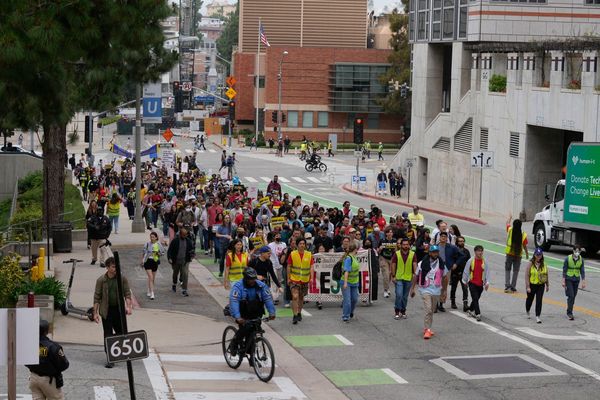
Outside this anteroom at the University of Queensland is a stock standard laboratory where, like most labs around the world, plastic is ubiquitous. The bench tops are laminated, there are plastic tubs and bottles everywhere and staff walk around in lab coats made from synthetic fibres. There is plastic in the air, on the floor and scientists drink out of it.
But in here, through a tightly sealed door, there is virtually none of the stuff. Through another door, in an air-locked corridor, scientists walk in, plastic-free, ready to enter a laboratory space that is unlike any other in the world.
Here, the insulating wall panels are made from aluminium. The floor, ceiling and walls are made from steel that is welded to avoid the use of silicone or plastic joins. The air-filters are made from paper.
“Affectionately, it’s called the submarine,” says Prof Kevin Thomas, the director of UQ’s Queensland Alliance for Environmental Health Sciences.
Inside this metal box – just 12 sq metres in size and funded by the foundation of the mining billionaire, Andrew Forrest – scientists hope to answer one of the world’s most pressing environmental questions: is plastic, and the multitude of chemicals that go with it, getting into the tissues in our bodies? And if it is, are humans being harmed?

“A normal lab is full of plastics and the chemicals used to make them. They’re abundant,” says Thomas. “But I don’t know if we can say that they’re dangerous yet. But I want to know.”
One fundamental problem that scientists studying exposure to plastics face is that even in a laboratory, there is a risk their samples are being contaminated during their experiments. If they find nano-sized plastics and chemicals in a tissue sample, they can’t be confident how it got there. Was the sample exposed during the everyday life of a human, or did the plastic get there during the testing?
This lab, says Thomas, aims to almost completely eliminate plastic so that samples can be extracted inside a special steel cabinet, then sealed in glass and moved outside to a piece of kit called a mass spectrometer.
“If you put two spoonfuls of sugar in eight olympic swimming pools, this could detect it,” says Thomas, pointing to a mass spectrometer with a sticker on it. “My Name Is NEGU,” the sticker reads.
NEGU stands for “Never, Ever Give Up,” a catchphrase of Forrest, its benefactor. Two weeks ago, Forrest also stood in the contamination-controlled lab to inspect the space. His Minderoo Foundation has pumped $3.2m into the equipment, and added another $1.3m to support the scientists that will do the work.
Scientists in the lab – part of Minderoo’s Plastics and Human Health centre at UQ – have already started working with blood, urine and brain tissues, fine-tuning their methodology ready for the start of the first tests, likely to be on human urine.

Thomas says they are working at sizes below 10 microns (one micron is one-1,000th of a millimetre). “That’s the size range that is feasible to cross biological barriers,” he says.
Humans and other living things around the world are exposed to plastic all the time. It is in the water that we drink, the food that we eat and the air that we breathe. It’s likely, Thomas says, that it is in our lungs and stomach even as we do this interview.
But is it being absorbed in our body? About four years ago, Thomas started an experiment on human blood, but the amount of plastic in the sample of blood was the same as a blank sample.
“We didn’t know if it was coming from the blood or the lab, so we parked that work,” he says.
During a workshop last year with the Minderoo Foundation, Thomas says there was much disagreement. Some scientists rejected any suggestion that plastic or the associated chemicals could make their way into human tissues.
Some – like Thomas – admitted they didn’t know, while at least one was utterly convinced the chemicals and plastics were already in our tissues.
The UQ and Minderoo team started to design the lab two years ago, sourcing as many plastic-alternative materials as possible. A “PVC-free” floor covering turned out not to be PVC-free.
But Thomas says tests in the lab’s environment have so far found no evidence of plastics or their associated chemicals – such as phthalates and bisphenols – below 500 nanometres (one sheet of paper is about 100,000 nanometres thick).
Prof Sarah Dunlop, who leads the plastics and human health work at the Minderoo Foundation, says: “There is so much public attention on microplastics but I think that is because we can see them. Our exposure to them is staggering.

“For nanoplastics – the reason we don’t know much about them is because it is so hard to measure. But is it linked to health impacts? We know they’re out there and we know about the risk.
“But this is about establishing whether or not there’s harm and then using that to drive change.”
While the “submarine” is cutting the chances of experiments being compromised, the team are also working with other scientists that are collecting samples, including the Sydney Brain Bank, to develop protocols to reduce the chances of plastic contamination during collection.
The task is mammoth, but Dunlop says getting an answer to the question of whether plastic is harming humans is like a scientific “holy grail”.
“People see plastic as a waste problem but not about the pollution inside our bodies – inside our children’s bodies – or how it might change how our brains develop. But that is what it is to be human.”







